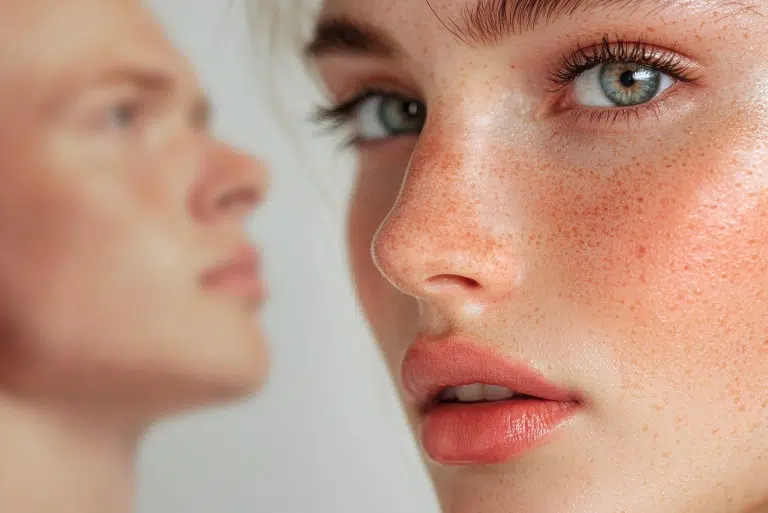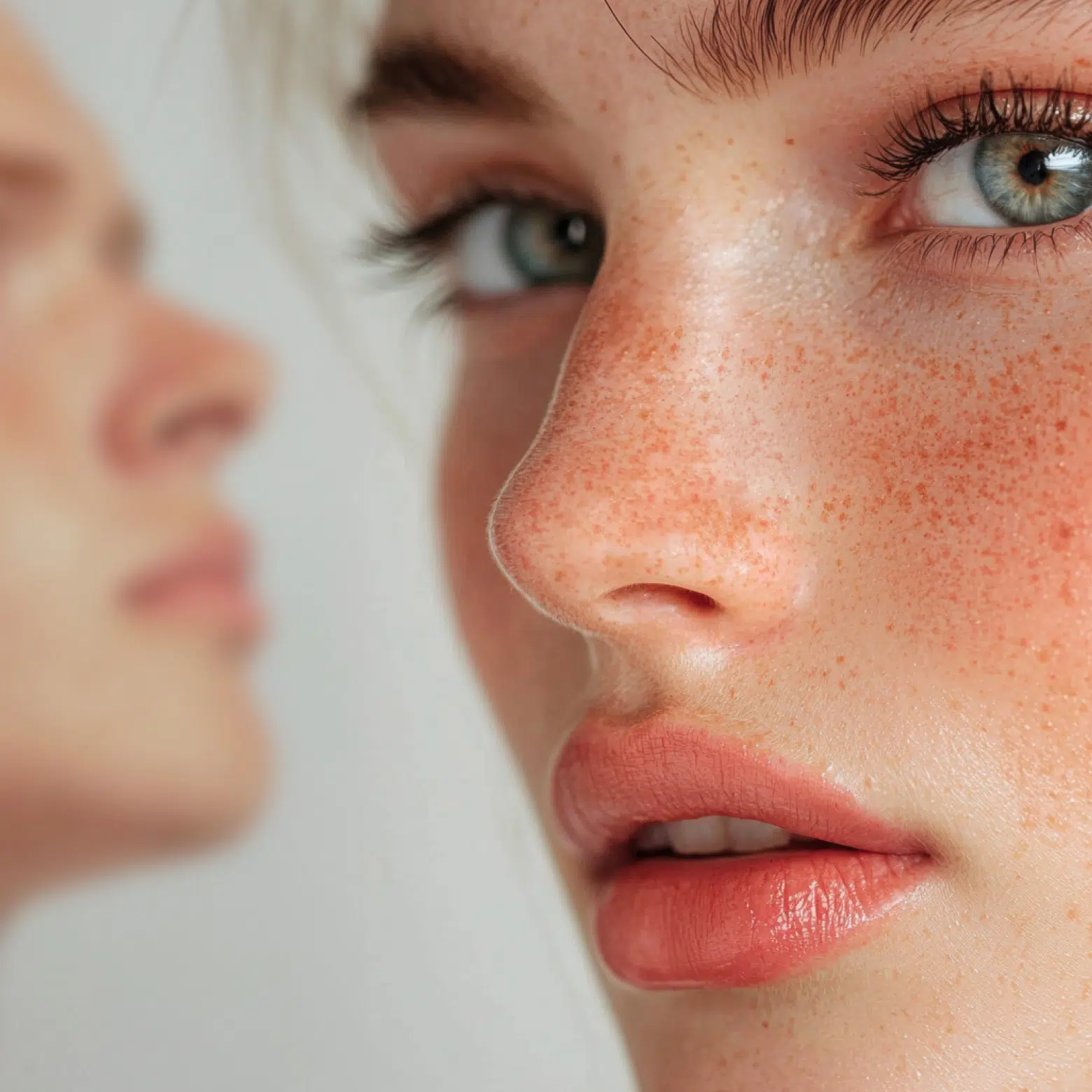Rhinoplasty
Rhinoplasty, also known as nose surgery, covers a wide range of aesthetic procedures. As the central element of the face, the nose can be the source of major complexes when its lines and proportions are not in harmony with other facial structures. Modern surgical techniques make it possible to improve the appearance of the nose and breathing through less invasive procedures with very natural and satisfying results.


What is rhinoplasty?
Rhinoplasty has come a long way in recent times, thanks to the refinement of surgical techniques and the emergence of so-called preservation techniques. In most cases, preservation rhinoplasty enables the desired changes to be made, while preserving certain structures that are important both functionally and aesthetically. Septoplasty is often performed to improve breathing in the case of a deviated septum.
If you’re looking for an overall improvement in profile, rhinoplasty can be accompanied by fat transfer or chin augmentation using chin implants, lipofilling or bone modification (profiloplasty).
Some cases do not require surgery, but a simple injection of hyaluronic acid to improve a small bump or a deviated appearance of the nose. This is known as medical rhinoplasty.
Do I qualify for rhinoplasty?
Rhinoplasty is a surgical procedure designed to improve the overall aesthetics of the nasal pyramid, whether by removing a hump, refining the tip, changing the length or width, or even improving breathing (septoplasty).
This procedure is suitable for anyone who has a complex about the appearance of their nose, or who has breathing difficulties due to structural abnormalities or after an accident. Modern techniques offer a host of highly satisfying possibilities when expectations are realistic. Rhinoplasty can be considered to correct congenital defects, trauma or to touch up previous surgery. All procedures are customized to meet the aesthetic and functional needs of each patient.
Procedure for a rhinoplasty at Leman Aesthetic Clinic?
At Leman Aesthetic Clinic, several types of rhinoplasty are available. An initial consultation with your surgeon will review your request and provide a detailed analysis of your nose and face. This will enable you and your practitioner to determine the best treatment option for you. Each procedure is carefully planned according to individual needs, with the help of simulation software.
Here are the different surgical techniques:
Closed rhinoplasty (simple cases)
- Duration: 1.5-2.5 hours
- Anaesthesia: General or local with sedation
- Hospitalization: Outpatient, sometimes 24 hours
- Time off work: 7-10 days
Open rhinoplasty (complex cases)
- Duration: 2-4 hours
- Anaesthesia: General
- Hospital stay: Outpatient, sometimes 24 hours
- Time off work: 2 weeks
Medical rhinoplasty
- Duration: Approximately 20-30 minutes
- Anesthesia: Local
- Hospitalization: None
- Time off work: None
What results can you expect after rhinoplasty?
Rhinoplasty delivers highly effective results significantly improving facial aesthetics. The volume and appearance of the nose are brought into harmony with the proportions of the other facial structures (chin, cheekbone, forehead). The final result is revealed gradually, over several months, as the edema disappears. They can be fully appreciated after 1 year.
What are the possible complications of cosmetic nose surgery?
As with any surgical procedure, rhinoplasty carries the risk of complications, although these are rare. Possible adverse events include infections, bleeding, reactions to anesthesia, and asymmetrical or unsatisfactory results requiring revision. It’s important to follow your surgeon’s post-operative recommendations to minimize these risks. Smoking cessation is essential to avoid scarring problems. Certain medications that promote bleeding should also be stopped on medical advice.
What is the cost of nose reshaping at the Leman Aesthetic Clinic?
The cost of rhinoplasty depends on the type of correction required.
- Rhinoplasty: from CHF 8,000
- Medical rhinoplasty (hyaluronic acid): CHF 900
FAQ
What is rhinoplasty?
Rhinoplasty, or nose surgery, is a procedure performed by a cosmetic surgeon to reshape or modify the shape of the nose to improve appearance or breathing function, using several techniques: hyaluronic acid injections or surgery for permanent results.
What is functional rhinoseptoplasty?
In some cases, rhinoplasty is considered reconstructive plastic surgery. This occurs when the procedure is primarily aimed at correcting functional problems of the nose, such as severe nasal obstructions due to deviations of the nasal septum or congenital malformations. In such cases, rhinoplasty is performed to restore the patient’s normal respiratory function, and therefore falls within the scope of reconstructive plastic surgery.
What are the main reasons why people opt for rhinoplasty?
Motivations for rhinoplasty can vary, but common reasons include improving aesthetic appearance (humps, deviations, unsightly tips, etc.), correcting functional problems of the nose, or a combination of both.
Who are the ideal candidates for rhinoplasty?
Ideal candidates for rhinoplasty are generally healthy adults who have realistic expectations of the results of the procedure. An evaluation by a plastic surgeon is necessary to determine eligibility.
What are the benefits of rhinoplasty preservation?
Preservation rhinoplasty, also known as tissue-preserving rhinoplasty, is a cosmetic nose surgery technique that aims to preserve as much of the nose’s natural anatomical structure as possible. Unlike other types of rhinoplasty, which sometimes involve the extensive removal of cartilage or bone tissue, preservation rhinoplasty focuses on subtly modifying and preserving the existing structure of the nose to achieve aesthetic results while retaining functionality and with superior stability of outcome. It is often used for adjustments such as the correction of bumps or irregularities, while avoiding significant alteration of the structure of the nose. This can lead to faster recovery and more natural results. However, the feasibility of this approach depends on the initial structure of each nose and the objectives of the surgery.
Is rhinoplasty painful?
Post-operative pain is generally well manageable with medication. Most patients experience discomfort and pressure rather than intense pain.
Is it possible to breathe after rhinoplasty?
Yes, most of the time we use nasal swabs that allow you to breathe through your nose after the procedure.
What can I expect after rhinoplasty?
After rhinoplasty, it’s important to follow the plastic surgeon’s instructions to ensure optimal healing. The recovery of a rhinoplasty can vary from person to person, but here’s generally what you can expect:
- Pain and swelling: you may experience pain, swelling and bruising around the nose and eyes for the first few days. This will gradually diminish. Bruising usually goes away completely after 2 weeks
- Plasters and casts: a nasal cast or plaster is placed to maintain the shape of the nose during healing. It will be removed after about a week
- Sutures: internal sutures fall out spontaneously after a few days. External sutures are removed after a week
- Respiratory discomfort: Despite the silicone pads that let you breathe, you may have some difficulty breathing through your nose for a while due to the internal swelling. This will gradually improve over the weeks
How long does it take to see the final results of rhinoplasty?
The final results of rhinoplasty can take several months, even up to a year, as the nose needs to stabilize and the swelling gradually disappear.
What is ultrasonic rhinoplasty and what are its benefits?
Ultrasonic rhinoplasty is an advanced surgical technique that uses an ultrasonic device (piezotome) to sculpt and reshape the nasal bones very precisely, while preserving the surrounding soft tissue. Although considered a gentler surgical technique, it requires greater tissue detachment and a slightly longer operating time.
How can I project myself with my new nose?
We usually make a 3D simulation of your new nose. This is a communication tool that helps us understand your expectations and explain the various modifications to be made. This is not a promise of results, as they depend on a number of factors. We can also show you before-and-after photos of previous patients to give you a realistic idea of possible results. A photo gallery is also available on our website.
What’s the difference between cosmetic surgery and aesthetic medicine when it comes to nose correction?
Cosmetic surgery involves surgical intervention to alter the structure of the nose, while aesthetic medicine offers non-surgical solutions, such as filler injections, for less invasive corrections.